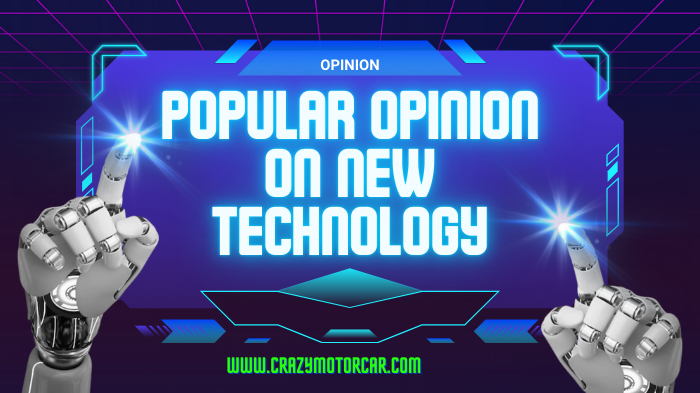Today's technology is developing quickly, allowing for quicker advancement and development, which accelerates the rate of change. Popular opinion on new technology however, a lot more has changed than only new and developing technologies, and IT professionals now understand that their job will shift in the contactless world of the future.
Additionally, in 2025, an IT worker will be continuously learning, unlearning, and relearning—out of need, if not want! For you, what does this mean? It entails keeping up with the most recent developments in technology.
It entails looking forward to determining what abilities you'll need to acquire in order to land a secure career in the future and even how to get there. The top 25 new technological developments for 2025 are listed below.
Best 25 Popular Opinions on New Technology

1. Artificial intelligence
Gen-AI, the buzzword of the town, is the first item on the list of new technological advances! By producing very rich and human-like material, including text, images, music, and intricate simulations, generative AI is poised to become a major technological trend in 2025 and transform whole sectors.
New applications in design automation, interactive experiences, and content generation are being fueled by developments in generative models, such as GPTs and multimodal systems.
In addition to increasing efficiency, this technology is transforming how companies handle consumer interaction, problem-solving, and creative processes while also making tools more widely available and adaptable. In order to develop more quickly and offer individualized services at scale, businesses will keep using generative AI into workflows in 2025.
Read also: RCA Opinion Car: A Comprehensive Guide
2. The use of quantum computing
For some jobs, quantum computers may process information exponentially faster than conventional computers by utilizing the features of quantum physics.
This year, quantum computing is being used in fields like drug research, where it might expedite the process by precisely replicating chemical structures, and cryptography, where it may be able to penetrate codes that are now thought to be safe.
Although the technology is still in its infancy, it has the potential to completely transform businesses by resolving challenging issues that conventional computers are unable to handle.
3. The expansion of 5G

5G is the next big thing in technology! Wider coverage, more reliable connections, and noticeably quicker upload and download speeds are all promised by 5G, the fifth generation of mobile networks.
5G's spread is making revolutionary technologies like the Internet of Things, augmented reality, and driverless cars possible by offering fast, low-latency connections.
This technology is essential for supporting a new generation of technological innovation by facilitating real-time communications and processing massive volumes of data with little latency.
4. VR 2.0, or virtual reality
Experiences are becoming more realistic and immersive thanks to improved VR technologies. VR is becoming more and more common in training, gaming, and therapeutic settings because of advancements in motion tracking, display resolutions, and interactive features.
With smaller headsets and better battery life, new VR systems are also getting easier to operate, which may encourage wider consumer acceptance and integration into daily life.
5. AR, or augmented reality
With its further integration into consumer and business applications, augmented reality (AR) is expected to be a significant technological trend in 2025. AR will provide increasingly engaging, interactive experiences as hardware advances, such as more sophisticated AR glasses and better mobile devices.
By improving how people learn, interact with their surroundings, and view items, this technology has the potential to revolutionize sectors including education, real estate, and retail.
By enabling users to smoothly superimpose digital data on the actual environment, AR-powered applications will help consumers close the gap between digital and real-world experiences.
6. Smart City Internet of Things (IoT)

In order to effectively manage assets, resources, and services, IoT technology in smart cities integrates a variety of sensors and data-collecting devices.
This entails employing smart grids to optimize energy consumption, putting in place linked systems for public safety and emergency services, and monitoring traffic and public transportation to lessen congestion.
IoT aids in managing complexity and enhancing inhabitants' quality of life as cities continue to expand.
7. Agricultural biotechnology
Biotechnology breakthroughs are transforming agriculture by making it possible to create crops with improved characteristics, such as greater resistance to pests and diseases, improved nutritional profiles, and larger yields.
Crops that can tolerate environmental challenges like drought and salt are produced using methods like CRISPR gene editing, which is essential for climate change adaptation and ensuring a food supply.
8. Self-Driving Cars
Autonomous cars, which employ AI, sensors, and machine learning to navigate and function without human assistance, are the next big technological revolution.
Although completely autonomous vehicles are still at the research and development stage, considerable strides have been made in incorporating varying degrees of autonomy into freight logistics and public transit, which may lower emissions, enhance traffic control, and prevent accidents.
9. Blockchain Beyond Crypto

Blockchain technology, which was first created for Bitcoin, is seeing new uses outside of the cryptocurrency space. Blockchain is being used by industries because of its capacity to improve security, decrease fraud, and give transparency.
Applications include preserving safe medical data, offering tamper-proof voting systems, and monitoring the origin of products in supply networks.
10. Utilizing Edge Technology
Instead of depending on a central data center, edge computing processes data close to where it is generated. Applications that need real-time processing and decision-making without the delay that cloud computing might introduce will find this especially crucial. Applications include local data processing in remote areas, industrial IoT, and driverless cars.
11. Customized Healthcare
Genetic, environmental, and lifestyle characteristics are used in customized medicine and therapy to accurately identify and cure illnesses.
Doctors may now choose therapies that enhance efficacy and limit negative effects because of developments in genetics and biotechnology.
In oncology, personalized medicine is especially revolutionary since certain treatments may target genetic abnormalities in cancer cells, improving patient outcomes.
12. Computing that is neuromorphic
Neuromorphic computing, which entails creating computer chips that replicate the neural architecture and processing mechanisms of the human brain, is the next big technological revolution.
These chips handle tasks like pattern recognition and sensory input processing more effectively because they process information in fundamentally different ways than standard computers.
This technique can significantly increase processing power and energy efficiency, especially in applications that need real-time learning and adaptability.
Read also: IndyCar Texas Breakdown with Agustin Canapino
13. Technologies for Green Energy

Enhancing the effectiveness and lowering the prices of renewable energy sources like solar, wind, and bioenergy are the main goals of innovations in green energy technology.
New designs for solar cells, wind turbines that run at reduced wind speeds, and biofuels made from biomass rather than food are examples of advancements. Achieving sustainability objectives and lowering the global carbon footprint depend heavily on these technologies.
14. Health Monitoring Devices
Many health parameters, including blood pressure, heart rate, and even blood sugar levels, are now continually monitored by sophisticated wearable technology.
These gadgets link to smartphones and analyze data using artificial intelligence (AI) to give consumers health insights and early alerts of any problems. Preventive healthcare and tailored health insights are becoming more popular as a result of this trend.
15. Training using Extended Reality (XR)
Virtual reality (VR), augmented reality (AR), and mixed reality (MR) are all included in extended reality (XR), which offers engaging training environments.
XR is used by sectors including manufacturing, healthcare, and aviation to provide risk-free, interactive training simulations that mimic real-world situations. This technology lowers training expenses, increases engagement, and improves learning results.
16. Technology Activated by Voice

Voice-activated technology has advanced to the point that devices can now more precisely comprehend and analyze genuine human speech.
Customer support bots, smart speakers, and home automation all make extensive use of this technology.
Through hands-free controls, it improves accessibility, convenience, and technological engagement, and it is becoming more and more incorporated into cars and public areas.
17. Travel to space
With the help of businesses like SpaceX and Blue Origin, commercial space travel is making tremendous progress. More people than only astronauts will be able to fly to space because of these advancements.
Plans for orbital flights and brief suborbital trips that give a few minutes of weightlessness are among the current options. Space tourism pushes the boundaries of aerospace science and technology while creating new opportunities for adventure.
18. Artificial Media
The term synthetic media, which includes deepfakes, virtual influencers, and automated video content, describes content that is completely produced by artificial intelligence.
In addition to providing a wealth of entertainment, educational, and media production opportunities, this technology poses important ethical problems. It makes it possible to develop material that is more and more similar to human-produced stuff.
19: Cutting-edge robotics
With the advancement of robotics technology, machines are now capable of carrying out intricate jobs either fully or partially without human supervision.
These robots work as surgical assistants in the healthcare industry, as personal helpers in homes, and in manufacturing, where they execute precise duties. Advances in AI and machine learning are increasing the capabilities and adaptability of robots.
Read also: Experience Luxury with the 2024 Honda Civic 4 Door Sedan
20. Cybersecurity using AI

By automating intricate procedures for threat detection and response, artificial intelligence plays a crucial role in improving cybersecurity.
AI systems are able to detect possible attacks, apply real-time protections, and search through enormous volumes of data for unusual patterns. In order to combat the growing sophistication and frequency of cyberattacks, this trend is essential.
21. Twins in digital form
Digital twins are computerized models of real-world equipment used for maintenance, monitoring, and simulation. They are widely utilized to anticipate possible problems and optimize operations in the automotive, urban planning, and manufacturing industries.
Businesses may evaluate effects and modifications in a virtual environment with digital twins, which saves money and time on testing in the real world.
22. Eco-Friendly Technology
As businesses place a greater emphasis on environmentally friendly products to fight climate change and reduce their influence on the environment, sustainable technology is becoming a key trend. This trend includes creating and utilizing technology that cuts carbon emissions, uses less energy, and supports the circular economy.
With an emphasis on long-term ecological balance, sustainable technology is redefining how organizations function, from data centers powered by renewable energy and energy-efficient gadgets to AI-driven solutions that optimize resource utilization. Growing consumer awareness, more stringent regulations, and the requirement that companies exhibit corporate social responsibility are the main forces behind the demand for sustainable technology.
Businesses are using blockchain, IoT, and AI developments to improve energy grids, waste management, and supply chains' sustainability. Adoption of sustainable technology will be a competitive advantage and a sign of environmental commitment in 2025 and beyond, as companies that adopt these technologies establish themselves as progressive leaders in a market that is becoming more and more aware of ecological effects.
23. Medical Telemedicine
Telemedicine eliminates the need for in-person visits by enabling patients to consult with physicians through digital platforms. It is now essential to provide ongoing medical treatment during emergencies like the COVID-19 epidemic.
Telemedicine is becoming a common way to deliver healthcare and is growing to offer additional services.
24. Nanotechnology
By modifying matter at the atomic and molecular level, nanotechnology may improve or create materials and gadgets with unique qualities. There are several uses, such as improved materials for greater product performance, more efficient medicine delivery systems, and advancements in electronics like more compact, potent circuits.
25. AI TRiSM (management of AI trust, risk, and security)

The revolutionary movement known as AI Trust, Risk, and Security Management (AI TRiSM) aims to guarantee the responsible and dependable application of AI technologies. By integrating trust, thorough risk assessment, and privacy protections across the AI lifecycle, it responds to the increasing need for security, transparency, and risk reduction in AI applications.
By putting in place frameworks that support explainability, bias detection, and strong governance, AI TRiSM helps enterprises to successfully manage risks associated with AI while building stakeholder confidence and adhering to regulatory requirements.
AI TRiSM makes ensuring AI systems stay transparent, safe, and ethical as they are increasingly incorporated into important decision-making processes.
This strategy lowers risk exposure, boosts stakeholder confidence, and encourages the deployment of AI in a sustainable way that complies with legal and cultural norms. By accomplishing this, AI TRiSM establishes a new benchmark for AI deployment that puts safety, responsibility, and trust first.
One way to be successful in 2025
These 25 new technological trends provide bright job prospects both today and in the near future, despite the fact that technologies are always developing and changing around us. The secret to succeeding in the future labor market and making a significant contribution to the tech-driven world will be embracing these new technological trends and advancements and developing pertinent abilities. Investigate and sign up for our excellent programs to advance your profession right now!
FAQ's: Popular Opinion On New Technology
What is your opinion on technology?
While some believe that technology has made life simpler, others disagree. How do you feel about this matter? I believe that individuals embrace and adjust to technology to the extent that works best for them. In several aspects, it makes life simpler, but in other aspects, it makes things more difficult.
How do people feel about new technology?
Thirty percent of Americans think technological changes will make life mostly worse in the future, while six out of ten (59%) think that life will be largely better.
What do you think about the latest technology?
Various benefits are offered by new technology in a variety of fields: 1. Efficiency: New technology frequently increases productivity and efficiency by automating jobs, streamlining processes, and cutting down on the amount of time needed to do them.
What is your opinion on emerging technologies?
Living with developing technology has numerous advantages, but there are drawbacks as well that must be considered. The loss of jobs is one of the most significant problems. Because robots and algorithms can now complete jobs that were previously completed by humans, automation and artificial intelligence may result in employment displacement.









